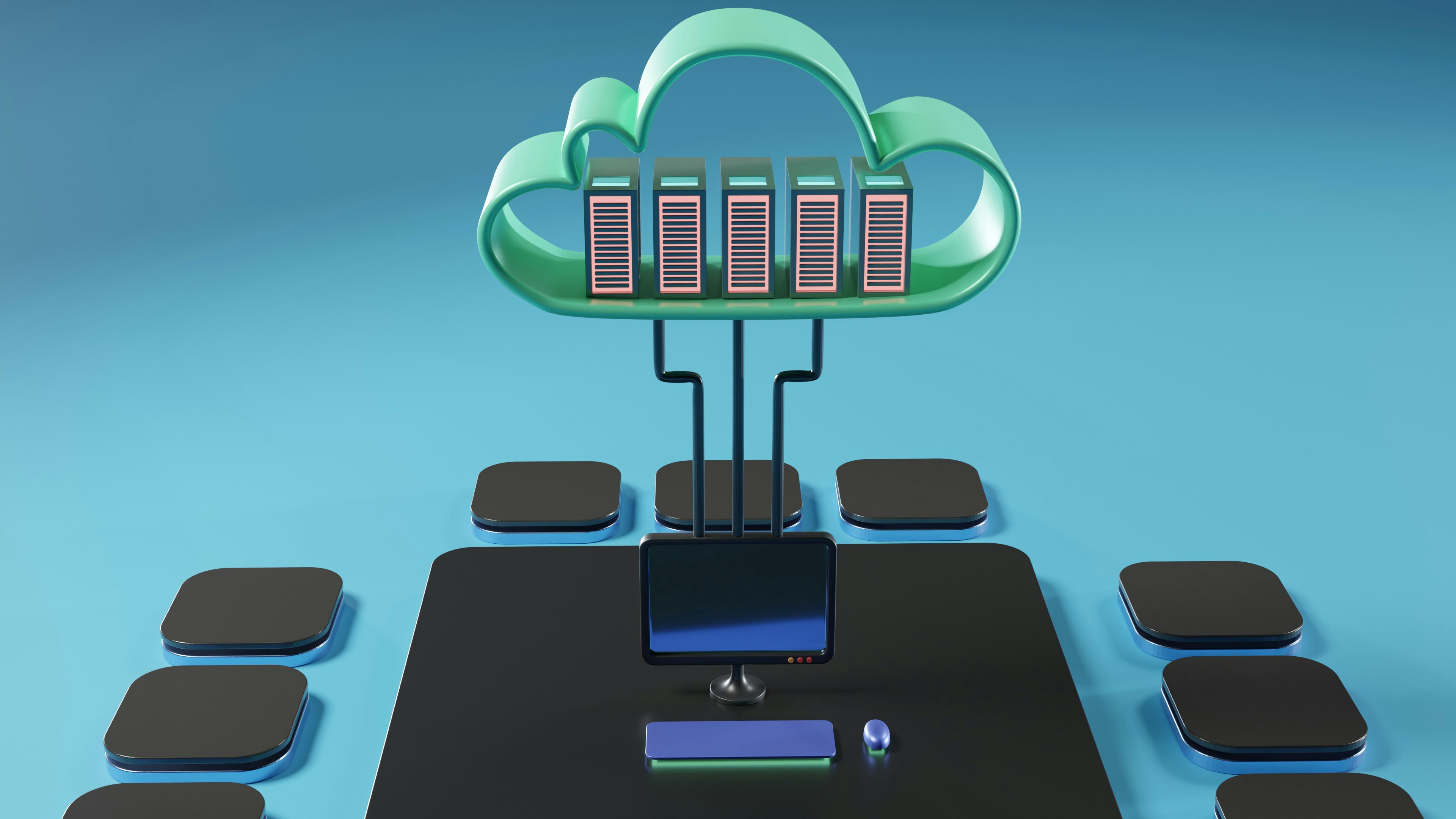Is your small business ready to scale, streamline, and thrive in 2025? Cloud computing is no longer a tool just for large enterprises. With accessibility at a peak and costs now more manageable than ever, cloud solutions are transforming how small businesses operate.
This guide will walk you through everything you need to know, from the basics of cloud computing to optimizing your business processes, safeguarding your data, and measuring ROI.

Whether you're new to cloud technology or ready to strengthen your current setup, this guide will make it clear, simple, and actionable.
What is Cloud Computing?
Simply put, cloud computing is the delivery of services like data storage, processing power, and software applications over the internet.
Instead of relying on bulky in-house servers or complicated IT systems, businesses can “rent” space and access cloud services as needed.
For example, if you use Google Drive to store files, QuickBooks Online for accounting, or Slack for team communication, you’re already leveraging cloud technology.
What makes it revolutionary is its flexibility and scalability, which allow businesses to adjust resources quickly without a significant upfront investment.
Why It Matters for Small Businesses in 2025
The advantages of cloud computing have leveled the playing field, allowing small businesses to compete with much larger organizations.
With more affordable and powerful tools available than ever, cloud technology empowers you to access enterprise-grade solutions without breaking the bank.
Here’s why the cloud is especially critical in 2025:
● Remote work is here to stay: Cloud solutions enable seamless collaboration regardless of where your team is located.
● Consumer expectations are rising: Real-time services, faster response times, and more secure data handling are now the norm. Cloud technology gives you the agility to meet these demands.
● Data security is non-negotiable: Top-tier cloud providers, such as AWS, offer built-in encryption, backups, and cyberthreat protection to safeguard your business.
Understanding Cloud Computing

What Is Cloud Computing Used For?
Cloud computing powers a wide variety of tasks, such as:
● Cloud Storage: Store files securely with services like Google Drive, Dropbox, and OneDrive.
● Automation Tools: Use software like HubSpot and Salesforce to streamline customer management.
● Collaboration Tools: Teams can work simultaneously on shared files with tools like Google Workspace.
● Software as a Service (SaaS): Access powerful apps like QuickBooks Online or Slack on a subscription basis.
No matter your industry, cloud computing can help save time, improve efficiency, and centralize workflows.
For instance, if you’re in retail, you can use cloud-based POS systems like Clover to manage sales, inventory, and customer information from anywhere.
Key Benefits of Cloud Computing for Small Businesses
● Cost Savings: Say goodbye to expensive hardware and IT maintenance. With pay-as-you-go models, you only pay for the resources you use.
● Scalability: Quickly scale resources up or down to match your business needs.
● Collaboration: Enable real-time teamwork and data sharing across locations.
● Security: Industry-leading encryption and regular updates keep your data safe.
● Flexibility: Work from anywhere with access to the tools and data you need.
Common Drawbacks and Challenges
While the cloud offers many benefits, it’s important to be prepared for potential challenges:
● Internet Dependency: A stable and fast internet connection is a must.
● Security Concerns: Shared environments can lead to vulnerabilities.
● Migration Costs: Moving data from on-premise systems to the cloud can be complex.
● Limited Control: Relinquishing direct oversight of IT infrastructure might feel risky for some businesses.
The key is careful planning and finding a reliable cloud partner that aligns with your business needs.
How Much Does Cloud Computing Cost?
Costs can vary widely depending on the services you choose. Many tools, like Google Workspace, offer free tiers but charge for additional storage or advanced features. On average:
● Basic cloud storage tools like Google Drive offer free plans, while premium versions start at around $15/user/month.
● Cloud-based accounting tools like QuickBooks Online start around $30/month.
● IaaS platforms like AWS often follow a pay-as-you-go pricing model, which can scale with your usage.
Learn more: Top AI Cloud Business Management Platform Tools You Need
Cloud Security Essentials

Optimized Security in the Cloud
With data breaches making headlines, security is non-negotiable. A reputable cloud provider will offer features like encryption, two-factor authentication, and activity monitoring to keep your data safe.
Ensure your provider complies with industry standards such as GDPR or HIPAA, depending on your business needs.
Additional Security Considerations for Cloud Computing
Here are some tips to protect your data in the cloud:
● Regularly audit user access levels.
● Implement strong password policies and multi-factor authentication.
● Choose a provider with top-tier certifications, such as ISO 27001 or SOC 2 compliance.
Visit Cloud Security Alliance for more insights.
Setting Up Cloud Security Measures
To establish a secure cloud environment:
● Encrypt data both in transit and at rest.
● Restrict access to sensitive information based on employee roles.
● Use automated alerts to monitor suspicious activity.
Understanding Cloud Licensing Agreements
Before committing to a provider:
● Assess user controls, data ownership, and backup features.
● Investigate costs tied to exceeding usage limits or canceling contracts early.
Streamlining Business Processes with Cloud Solutions

Business Automation with Cloud Tools
From invoicing to inventory tracking, cloud tools can automate repetitive tasks, saving you time and reducing human error. For example, a CRM like Salesforce can streamline customer follow-ups and generate insights for better decision-making.
Improved Team Collaboration
Use tools like Microsoft Teams or Google Workspace to connect remote and in-office team members. Real-time document sharing and communication ensure everyone stays on the same page.
Consider adopting project management software, such as Trello or Monday.com, to stay organized.
Cloud-Based Data Storage and Backup
Services like AWS or OneDrive offer reliable data storage with automated backups, protecting your business from data loss or system failures.
Leveraging Professional Software
Cloud computing offers affordable access to enterprise-grade SaaS tools:
● CRM: Scale customer management with Salesforce or HubSpot.
● Accounting: Streamline financial tracking with QuickBooks or FreshBooks.
● Email Campaigns: Launch smarter marketing campaigns with tools like Constant Contact.
Adopting Cloud Solutions for Your Business

Choosing the Right Cloud Solutions
To find the best fit for your business:
● Identify your specific needs (e.g., storage, CRM, email, or e-commerce).
● Research providers that specialize in your industry.
● Start with free trials to test compatibility and user experience.
Moving Data from On-Premises to the Cloud
A smooth migration requires a strategic plan:
● Assess which data and systems to move first.
● Backup all critical files before beginning.
● Test functionality before fully transitioning.
Preparing Employees for a Cloud-Based Workflow
Provide training sessions and create clear guides to help your team adapt. Highlight the benefits of cloud tools to minimize resistance.
Calculating the ROI of Cloud Adoption
Measuring Efficiency Gains and Cost Savings
Compare your current IT expenses with projected cloud costs. Factor in time savings and increased productivity to get a full picture.
Assessing Long-Term Scalability and Flexibility
Cloud solutions allow you to adapt quickly to market changes, ensuring you’re always ready to scale or pivot when needed.
Staying Up to Date with Cloud Providers
Learning About Updates and New Features
Cloud services evolve constantly. Whether it’s new integrations or enhanced security, staying informed ensures you’re leveraging the best tools.
Keeping Security Protocols Current
Regularly review your provider’s security features and implement updates promptly to stay protected.
Managing Licensing and Subscription Models
Plan your budget by tracking licensing renewals and adjusting subscriptions based on usage.
Taking the Next Step with Cloud Computing
Cloud computing is no longer optional for small businesses that want to thrive in 2025. It’s your ticket to scalable systems, seamless workflows, and significant savings.
The key is to stay informed, pick the right provider for your specific needs, and take small, steady steps toward full adoption.
Want help implementing a cloud strategy? Contact us for tailored solutions designed to make your migration smooth, secure, and impactful. It’s time to work smarter, not harder.
FAQ: Cloud Computing for Small Business Guide 2025
1. What is cloud computing?
Cloud computing provides services like storage, software, and tools over the internet. This eliminates the need for on-site servers, allowing you to access your data and apps online.
2. How can cloud computing benefit my small business?
Cloud computing offers cost savings, scalability, and improved collaboration. It also enhances data security, streamlines workflows, and provides flexibility to adapt as your business grows.
3. Is cloud computing affordable for small businesses?
Yes, pricing is highly flexible. You can choose from pay-as-you-go plans or subscriptions, starting as low as a few dollars per user, based on your specific needs and usage.
4. How secure is cloud computing?
Most providers use advanced security measures like encryption, firewalls, and regular updates to protect your data. Using strong passwords and multi-factor authentication adds extra protection.
5. Can I migrate my current data to the cloud?
Absolutely! Many cloud services include migration tools and support to help transfer your business data smoothly. Planning and employee training ensure a seamless transition.
6. What should I look for when choosing a cloud service?
Look for services that offer strong security, scalability, ease of use, and good customer support. Always read the terms carefully to ensure they align with your business goals.




